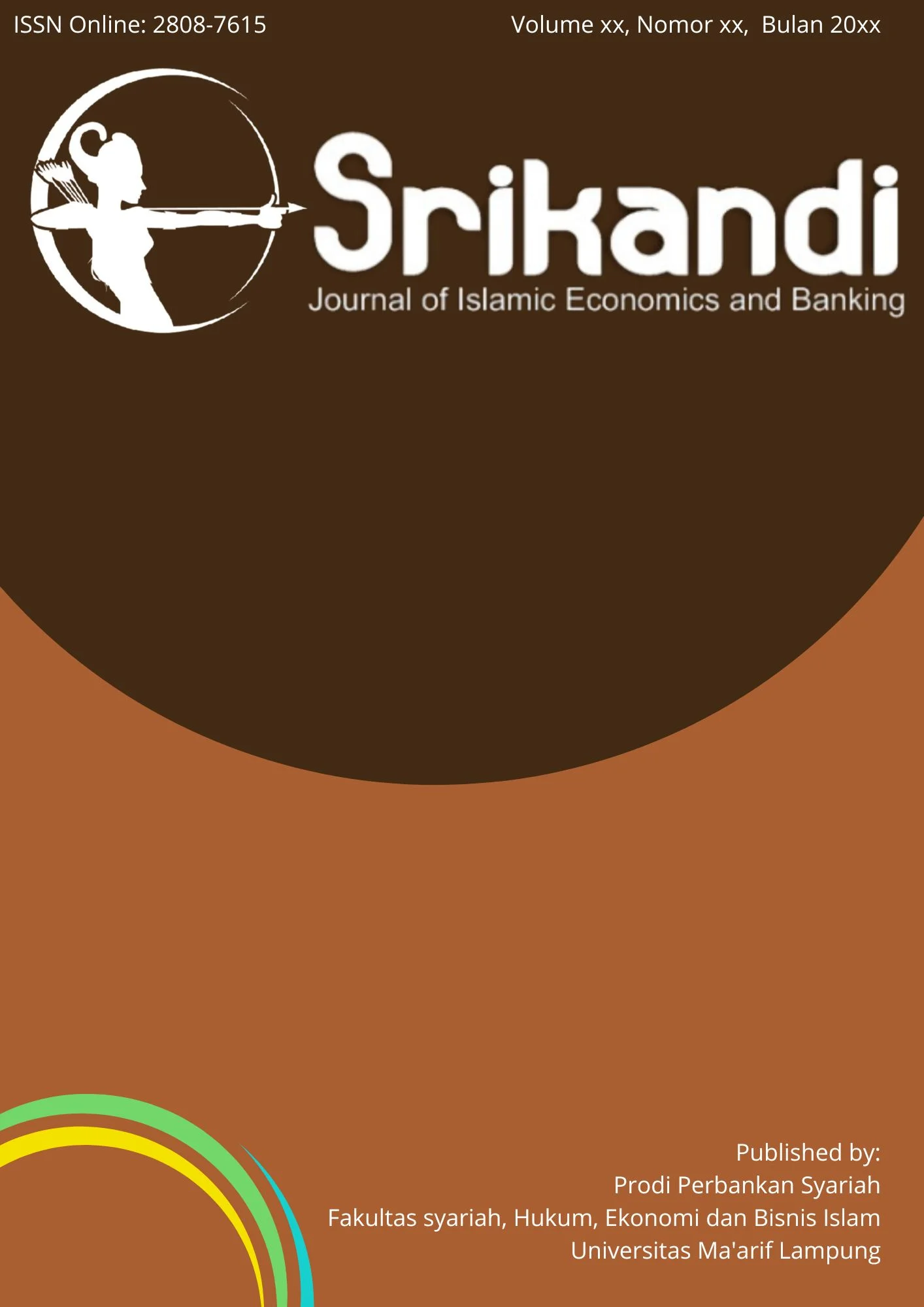Analisis Sistem Cicil Emas Pada Pembiayaan Murabahah Dalam Meningkatkan Aset di Bank Aman Syariah Kota Metro
DOI:
https://doi.org/10.25217/srikandi.v3i1.6421Keywords:
Gold installment system, murabahah financing, Asset IncreaseAbstract
Bank Aman Syariah is one of the Islamic financial institutions that collects funds from the community and distributes the funds back to the community. The problem that occurs at Bank Aman Syariah is the lack of customer understanding of the gold installment procedure, that the gold installment advance does not use collateral, because the collateral is the gold. So when the collateral is paid off, the gold can be given directly to the customer, but here the customer's understanding assumes that when the gold contract is completed, it can be given directly, even though the procedure from Bank Aman Syariah when the gold is paid off, the gold can be received by the customer. The purpose of this study is to determine the gold installment system and asset growth at Bank Aman Syariah. This type of research is field research using a qualitative descriptive approach, and data collection techniques are observation, interview, and documentation methods. The data analysis techniques used are data collection, data reduction, data presentation, and drawing conclusions. The results of this study are the gold installment system at Bank Aman Syariah in the form of monthly installments, for the calculation of gold installments at Bank Aman Syariah, the Bank provides financing at the beginning of a maximum of IDR 5,300,000, then the customer pays a down payment (DP) of IDR 1,300,000, then the Bank offers the customer how many years to take installments, if the customer takes 1 year then the installments are IDR 200,000 / IDR 300,000 per month. For the increase in assets in 2021-2023, each year has increased. In 2021, the nominal assets were IDR 21,592,755, then in 2022 there was an increase in assets of IDR 28,691,213, and in 2023 the asset quality increased and reached IDR 42,797,054.
References
Agustina, Y., & Asmara, F. (n.d.). Evaluasi Perlakuan Akuntansi Aset Tetap pada Cv Sarana Adi Putra Periode 2017 S/D 2018. Jurnal Riset Akuntansi, 12(1), 95–104.
Al Arif, M. N. R. (n.d.). Lembaga Keuangan Syariah, Suatu Kajian Teoretis Praktis.
Anam, M. K., & Santoso, H. (2019). PERAN PEMBIAYAAN MURABAHAH DALAM MENINGKATKAN USAHA BATU BATA (STUDI PADA BMT AS-SALAM KANTOR KAS NGERECO KANDAT KEDIRI. I-ECONOMICS: A Research Journal on Islamic Economics, 5(1), 64–76.
Brigham, E. F., & Houston, J. F. (n.d.). Dasar-dasar manajemen keuangan.
Farida, A., Kurniawati, V., & Rahmawati, R. (2022). Implementasi Akad Wadi’ah pada Produk Simpanan Qurban: Study Pemikiran Muhammad Syafii Antonio. Jurnal Tana Mana, 3(1), 1–11.
Fauziyah, E. (2019). Analisis Mekanisme Dan Penerapan Akad Pada Produk Cicil Emas Terhadap Minat Nasabah Dalam Perspektif Ekonomi Islam (Studi Pada Bank Syariah Mandiri KCP Unit 2 Tulang Bawang.
Hasanah, H. (n.d.). Teknik-teknik observasi (sebuah alternatif metode pengumpulan data kualitatif ilmu-ilmu sosial. At-Taqaddum, 8(1), 21–46.
Herdiansyah, H. (n.d.). Wawancara, observasi, dan focus groups: Sebagai instrumen penggalian data kualitatif.
Hidayaturrahmaniah, N. (2023). Analisis implementasi akad murabahah pada produk pembiayaan cicil emas di Bank Syariah Indonesia KCP Selong.
Indahningrum, R. P., & Handayani, R. (n.d.). Pengaruh kepemilikan manajerial, kepemilikan institusional, dividen, pertumbuhan perusahaan, free cash flow dan profitabilitas terhadap kebijakan hutang perusahaan. Jurnal Bisnis Dan Akuntansi, 11(3), 189–207.
Koperasi, S. P. (n.d.). Peraturan Menteri Negara Koperasi dan Usaha Kecil dan Menengah Republik Indonesia. Kementerian Negara Koperasidan Usaha Kecil dan Menengah Republik.
Marlina, A., & Hartati, Y. (2019). Prosedur Pembiayaan Cicil Emas Di Bank Syariah Mandiri Kcp Sudirman Bogor. Moneter: Jurnal Keuangan Dan Perbankan, 7(1), 1–7.
Melina, F. (2020). Pembiayaan Murabahah Di Baitul Maal Wat Tamwil (Bmt. Jurnal Tabarru’: Islamic Banking and Finance, 3(2), 269–80.
Muhammad, M. P. B. S. (n.d.). Yogyakarta: UPP AMP YKPN, 2002. Manajemen Bank Syariah.
Nilamsari, N. (n.d.). Memahami studi dokumen dalam penelitian kualitatif. WACANA: Jurnal Ilmiah Ilmu Komunikasi, 13(2), 177–81.
Pengembangan, T. (n.d.). Perbankan Syari’ah Institut Bankir Indonesia: Konsep, Produk dan Implementasi Operasional Bank Syari’ah. Djambatan.
Pontoh, E. L., Morasa, J., & Budiarso, N. S. (n.d.). Evaluasi penerapan perlakuan akuntansi terhadap aktiva tetap berdasarkan PSAK No. 16 tahun 2011 pada PT. Nichindo Manado Suisan. Jurnal EMBA: Jurnal Riset Ekonomi, Manajemen, Bisnis Dan Akuntansi, 4(3).
Qomariyah, N. (2014). Penentuan Margin Akad Murabahah pada Bank Muamalat Indonesia Cabang Malang.
Rahardjo, M. (n.d.). Metode pengumpulan data penelitian kualitatif.
Rivai, V., & Veithzal, A. P. (2008). Islamic financial management: teori, konsep dan aplikasi panduan praktis untuk lembaga keuangan, nasabah, praktisi, dan mahasiswa. Rajawali Press.
Santoso, H. (n.d.). MENCEGAH PEMBIAYAAN BERMASALAH DENGAN MONITORING DAN PENGAWASAN PRESPEKTIF VAITHZAL RIVAI. Al-Mansyur: Jurnal Ekonomi Dan Bisnis Syariah, 2(2), 1–10.
Silvi, O. (2019). STRATEGI PEMASARAN PEMBIAYAAN PRODUK CICIL EMAS (STUDI KASUS BANK SYARIAH MANDIRI KANTOR CABANG BINTARO.
Sri Wahyuni, S. E., Dev, M. E., Khoirudin, S. E. R., & Dev, M. E. (2020). Pengantar Manajemen Aset. Nas Media Pustaka.
Sujarweni, V. W. (n.d.). Metodelogi penelitian. Pustaka Baru Perss.
Yuliana, R., & Herawati, N. (n.d.). Dampak Penghapusan Pajak Pertambahan Nilai Pada Pembiayaan Murabahah Terhadap Kinerja Keuangan Bank Syariah. InFestasi, 10(2), 88–102.



